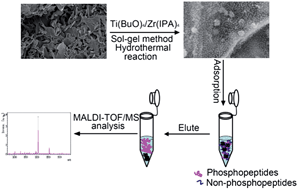A novel rGR–TiO2–ZrO2 composite nanosheet for capturing phosphopeptides from biosamples†
Abstract
A novel rGR–TiO2–ZrO2 (rGTZ) composite nanosheet comprising graphene oxides, tetrabutyl titanate, and zirconium(IV) isopropoxide was synthesized using a simple sol–gel method and hydrothermal treatment. The excellent surface area of graphene and the specificity of TiO2 and ZrO2 toward phosphopeptides were integrated to form a composite with a high number of specific sites for the capture of phosphopeptides from complex biosamples. The average diameter of the nanoparticles that were loaded onto the flat graphene surface was 100 nm, according to a TEM analysis. The adsorption behaviors of the materials were evaluated using the Langmuir model equation, and the Qmax values of the commercial TiO2, GTZ, and rGTZ were calculated to be 373.1 mg g−1, 250.0 mg g−1 and 490.2 mg g−1. Beta-casein was applied as a standard protein to optimize the conditions for phosphopeptide enrichment. Different materials (GTZ and commercial TiO2) were used to demonstrate the superiority of the rGTZ composite nanosheet for capturing phosphopeptides from tryptic digests of β-casein under the optimized conditions. Various complex samples (α-casein, mixtures of β-casein and bovine serum albumin, which were used as examples of semi-complex samples, non-fat milk, and mouse organs) were exploited to evaluate the capabilities and efficiency of the rGTZ nanosheet composite. 1980 phosphopeptides from 1769 proteins from mouse brain and 577 phosphopeptides from 1267 proteins from mouse liver were identified by their enrichment in mouse brain and liver using rGTZ nanosheet composites.


 Please wait while we load your content...
Please wait while we load your content...